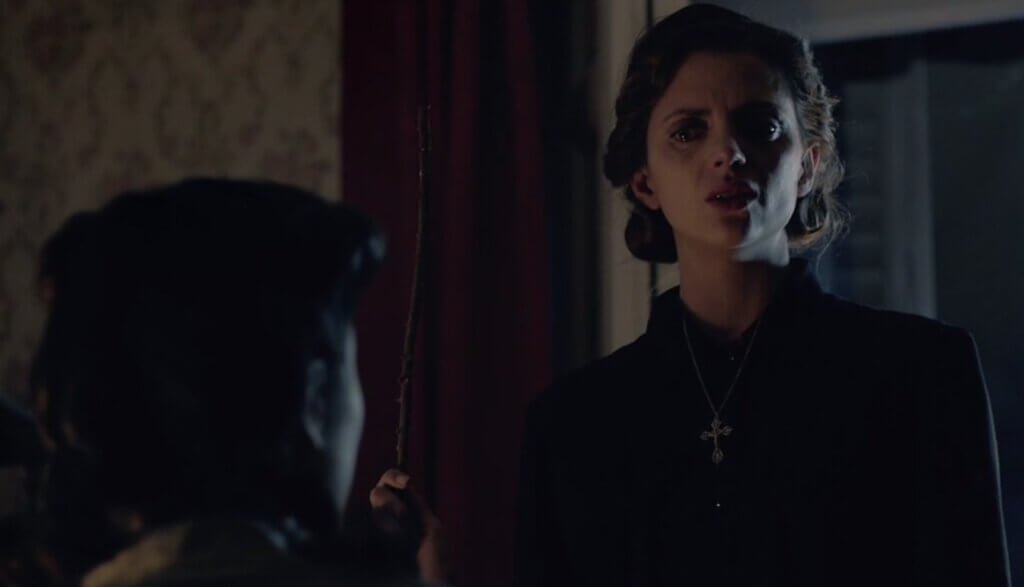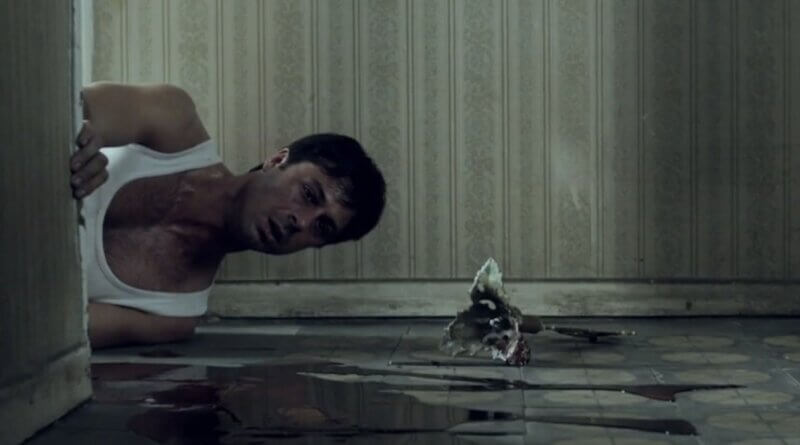Shrew’s Nest (2014), A Violent Case of Agoraphobia in 1950s Spain
It’s always irksome when filmmakers use sexual trauma as the basis for violence and bloodshed. Yes, sexual abuse (especially in children) is a particularly vicious cycle. In fact, childhood abuse makes it three times more likely that the victim will go on to victimize others as an adult. However, filmmakers often use this statistic to make every victim into an abuser, psychopath, or violent criminal. For better or worse, this trope plays out with blood-splattering gusto in Esteban Roel and Juan Fernando Andrés’ 2014 period horror film, Shrew’s Nest (or Musarañas).
Set in 1950s Spain, a deeply religious agoraphobe, Montse (Macarena Gómez), cares for her younger sister, Nia (Nadia de Santiago). Despite being unable to step foot outside of the apartment, Montse works as a freelance seamstress while Nia lives life as usual and runs errands for her sister. Montse attempts to remedy her condition with morphine, though her supplier recommends therapy.
In addition to the agoraphobia, morphine addiction, bitterness over her lost youth, and religious zeal, Montse must also battle the ghosts of her past, particularly hallucinations of her cruel father. However, Montse’s zealotry and emotional instability have taken their toll on her relationship with Nia, especially when Montse feels Nia slipping away from her faith and the household.
After Montse looks through her window to see Nia flirting with a boy on the street, she becomes violent and throws Nia out of the apartment. Nia spends the evening in the hallway, where she is briefly observed by their upstairs neighbor, Carlos (Hugo Silva). After Nia wakes up, Montse allows her to reenter the apartment, though Nia still fears for her safety.
Meanwhile, Carlos wants to escape his current life but fails to make it past the stairwell, where he falls and breaks his ankle. Bloodied and half-conscious, he crawls to the nearest door he can find, where Montse initially rejects him. However, after thinking it over for a while, she eventually drags him in and begins to care for his wounds. Thus, Carlos has entered the SHREW’S NEST!

At first, Montse keeps Carlos secretly locked away in a back room of the Madrid apartment. She feeds him morphine to keep him docile. She also assures him that a doctor has come by while he’s been asleep. Her exact reasons for keeping him are unclear at first, though we come to learn that she is building some kind of fantasy world in which Carlos will be her loving husband. Unfortunately for her, Carlos only has eyes for Nia. Either way, he would still prefer to just go to the hospital and leave both of them behind.
As the plot unfolds and we come to learn more about their family secrets, Montse struggles to keep the situation under control. Nia discovers Carlos and wants to help free him. At the same time, other people start looking for Carlos, including his fiancee. The increasing pressure leads Montse on a violent rampage, even as she keeps herself confined to her dreary home.
Though the plot is vastly different, Shrew’s Nest (2014) pays a lot of homage to Misery (1990). The latter is a far superior film that creates a much greater sense of dread and isolation. Nonetheless, there are plenty of things that Shrew’s Nest does well.
By the end of it all, the violence borders on cartoonish, with severed heads popping up out of nowhere. In my opinion, this actually works to its advantage, even if it feels a bit out of place. However, we come to learn so much about Montse’s character that it feels like an episode of Law & Order: SVU, where every misdeed must be explained by past trauma. I don’t want to give away too many spoilers, so I won’t discuss the ending in detail. However, it does feature its fair share of twists and turns — albeit predictable ones.
To the film’s credit, it is quite engaging. It will keep you on the edge of your seat from start to finish. Even if it does deal with abuse and trauma in a very amateur, oversimplified way, the plot works quite well. There are elements of a very subtle, dark comedy in between the more melancholic moments, though they don’t always fit well with the overall tone of the film. It might have worked with different players, but the actors are just not up to the task. There are moments when the performances will make your eyes roll, though Macarena Gómez still outshines the rest.
Shrew’s Nest (or Musarañas in Spain) is a period horror film that almost hits the mark but misses in a few key areas. The characterizations are too simplistic and overused, while the acting leaves a lot to be desired. At the same time, the film doesn’t feel nearly as claustrophobic as it should; a missed opportunity that leaves the entire endeavor lacking the tense atmosphere it requires to be truly frightening and effective. That said, Shrew’s Nest (2014) is exactly the kind of film you watch when you want to see over-the-top bloodshed and family mysteries unfold. In short, it is pretty satisfying and entertaining; nothing more and nothing less.
Shrew’s Nest (2014) Movie Rating: ★★½ out of 5
If you’d like to watch Shrew’s Nest (2014), it is currently available to rent, purchase, or stream on Amazon Prime. For more film reviews like this one, be sure to check out the Philosophy in Film homepage!

